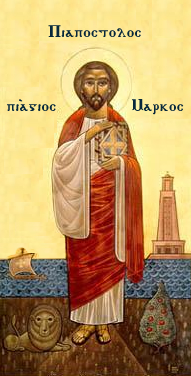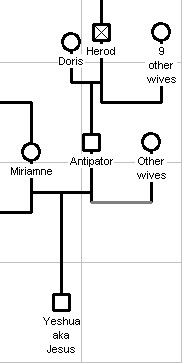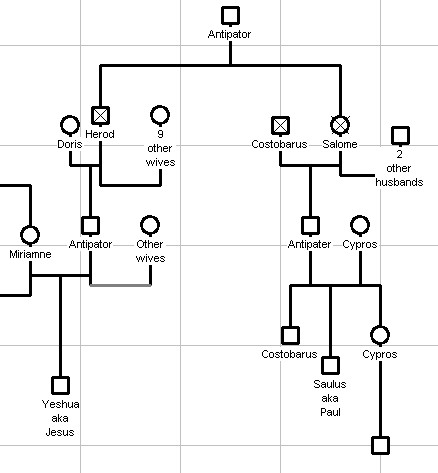- Joseph. The simplest suggestion. Matthew and Luke, but not Mark, claim that Maria the mother of Jesus had a husband called Joseph. The plot has
 her pregnant before their marriage, and Joseph marrying her anyway. Later theology wanted a miraculous birth, and so the plot in Matthew and Luke removed his biological parentage. Why not assume that Joseph is actually the biological father? It is generally assumed that he was the father of Jesus’ siblings mentioned in Mark 6:3: James, Joseph, Simon, Judas and two unnamed sisters. On the other hand, Joseph is not in Q the pre-cursor of Luke and Matthew, nor Marcion an earlier version of Luke. In John there is passing reference to Jesus son of Joseph, but this could be as easily a reference to Jesus as the Messiah ben Joseph as a reference to parentage.
her pregnant before their marriage, and Joseph marrying her anyway. Later theology wanted a miraculous birth, and so the plot in Matthew and Luke removed his biological parentage. Why not assume that Joseph is actually the biological father? It is generally assumed that he was the father of Jesus’ siblings mentioned in Mark 6:3: James, Joseph, Simon, Judas and two unnamed sisters. On the other hand, Joseph is not in Q the pre-cursor of Luke and Matthew, nor Marcion an earlier version of Luke. In John there is passing reference to Jesus son of Joseph, but this could be as easily a reference to Jesus as the Messiah ben Joseph as a reference to parentage. - Cleophas (Clopas)/Alphaeus (Alpheus). Cleophas is mentioned in John 19:25 as the husband of Mary, said to be the sister of Jesus’ mother, and in Luke 24:13-27 as a disciple. Alphaeus is said to be the father of James in Matthew 10:3, Mark 3:18, Luke 6:15 and Acts 1:13. He is also the father of Levi (whom some take to be another name for Matthew) at Mark 2:14. As the father of James is probably the husband of Mary, Cleophas and Alphaeus are usually taken to be the same person, and convoluted arguments have been proposed as far back as Papias that Cleophas is a Greek transliteration of the Aramaic Alphaeus. James D. Tabor in chapter 4 of his The Jesus Dynasty, 2006 argues that we should assume that Cleophas/Alphaeus is the levite brother of Joseph, that is that he is a younger brother who married his brother’s widow and in the Hebrew fashion raised future children with the widow as if they were children of Joseph. Eisenman, however, in his James, The Brother of Jesus, takes it that Cleophas/Alphaeus is the name of the husband of Mary, and that it was changed to Joseph by association with the Messiah ben Joseph tradition in Galilee/Samaria.
- Antipater (46 – 4 bce), eldest son of Herod and his first wife, Doris. We discussed this earlier. As proposed by Robert Graves, and taken over by Graham Phillips without credit, if Jesus were the son of Antipater, he would be a Roman citizen and be recognized by the Romans, and especially Pilate, as a rightful king of the Jews. This would explain Pilate’s granting of a private audience, see John 18:29-38. Incidentally, Antipater, like Jesus, was a son sacrificed by his father. As Herod was dying, he accused his son of planning his murder and had him executed. Some writers have seen this as a magical sacrifice. If it was, it failed, in that Herod died soon after the execution.
- Tiberius Julius Abdes Pantera (22 bce – 40 ce). Celsus, the 2nd century philosopher, in his On the True Doctrine, says of Jesus: “His mother had been turned out of doors by her husband, who was a carpenter by trade, on being convicted of adultery with a soldier named Panthera”. Furthermore the Tosefta, also 2nd century, refers to one Yeshua ben-Pandera, whom some take to be the Christ Jesus. These suggestions took on extra life when in 1859 a tombstone of this name dating to the early 1st century was discovered in Bingerbrück on the Rhine (map). Abdes was from Sidon in Phoenicia and of the same generation that Maria would have been. The suggestion that we have the grave of Jesus’ father was first made by Marcello Craveri in his La vita di Gesu, 1966. It has been adopted by James D. Tabor and is discussed in detail in chapter 3 of his The Jesus Dynasty, 2006.
- Parthenogenesis. The idea that there is no father. Reptiles can reproduce by parthenogenesis, so why not mammals, so why not humans? Anthony Harris ran with this idea in his The Sacred Virgin and the Holy Whore, 1988. A parthenogenic child could not have XY chromosomes and therefore cannot be male. Furthermore it cannot even be XX as it has only one parent. It would have X0 chromosomes, which is Turner’s Syndrome. Such children, about 1 in 2500 female births, have undeveloped female sexual organs. 98% of X0 fetuses spontaneously abort, and the condition accounts for about 10% of all spontaneous abortions.
- Yahweh. If Jesus is the ‘son of God’ in the Christian rather than the Jewish (Benei Elohim) or the Roman (divi filius) sense, the god meant is Yahweh. The Nicene Creed says: “begotten of the Father”. Presumably such a god could provide the Y chromosome to produce a male child. Philo tells us that Isaac was not the son of Abraham, but was the son of Yahweh himself who created Isaac directly in the womb of Sarah. See “God Begat Isaac” in Howard Schwartz, Tree of Souls: The Mythology of Judaism p336.
- Allah. If, as some maintain, Allah is Yahweh by another name, then Allah is the father of Jesus. Most Christians are uncomfortable with the equation of Allah and Yahweh; most Moslems are uncomfortable with the idea of Allah as a father. However Surah 3:45-49 maintains that Mary became
 pregnant at the will of Allah, and without sexual intercourse. On the otherhand, Surah 37:151 says “Surely they lie when they declare: “Allah has begotten children”.
pregnant at the will of Allah, and without sexual intercourse. On the otherhand, Surah 37:151 says “Surely they lie when they declare: “Allah has begotten children”. - Zeus. Zeus admits to many children: Athena, Aphrodite, Dionysos, Apollo, Artemis and more. He frequently resorted to disguise to seduce mortal women. In fact, it was fatal for Semele, mother of Dionysos, to demand that Zeus appear as his real self, and so we can understand that he did dissimulate. Several ancient authors saw Jesus as another form of Dionysos.
- The Holy Spirit. Regarded by Christians as the third person on the Godhead. It is not clear how the statement that Jesus was fathered by the Holy Spirit has a different meaning from the statement that he was fathered by God the Father(Yahweh). Matthew 1:25 states that Mary’s conception “is of the Holy Spirit”
- Gabriel. In Luke only, Gabriel announces the pregnancies of both Elizabeth and Mary, with a suggestion that he might in fact be the father. The King
 James Bible has it that: “the angel came in unto her (Luke 1:28). It is often commented that Muhammad confused the Holy Spirit and Gabriel (Gibril), but such confusion is understandable. The Quran calls Gibril ‘Ruhhil Qudus'(=Holy Spirit). It was also Gabriel that gave Muhammad the Quran. The Midrash Elah Ezkerah tells us with regard to the birth of Rabbi Ishmael that Gabriel took the form of his father to meet the mother at the bathhouse, and took her home, and that night Rabbi Ishmael was conceived. That is why Rabbi Ishmael was so handsome: he resembled his father, Gabriel. See “How Rabbi Ishmael was conceived” in Howard Schwartz, Tree of Souls: The Mythology of Judaism p201.
James Bible has it that: “the angel came in unto her (Luke 1:28). It is often commented that Muhammad confused the Holy Spirit and Gabriel (Gibril), but such confusion is understandable. The Quran calls Gibril ‘Ruhhil Qudus'(=Holy Spirit). It was also Gabriel that gave Muhammad the Quran. The Midrash Elah Ezkerah tells us with regard to the birth of Rabbi Ishmael that Gabriel took the form of his father to meet the mother at the bathhouse, and took her home, and that night Rabbi Ishmael was conceived. That is why Rabbi Ishmael was so handsome: he resembled his father, Gabriel. See “How Rabbi Ishmael was conceived” in Howard Schwartz, Tree of Souls: The Mythology of Judaism p201.
16 November 2007
Jesus’ Daddy – the candidates
2 October 2007
Salome: goddess, saint, disciple, herodian
- There are two Salomes in Josephus: Salome, the sister of Herod, called the Great; and Salome daughter of Herod son of Herod “the Great” and Mariamne daughter of Boethus. On her mother’s side, this second Salome was daughter of Herodias, daughter of Aristobulus who was son of Herod “the Great” and his other wife also called Mariamne who was one of the last survivors of the Maccabean dynasty. Also note that the second Salome was first cousin to Berenice, wife to two kings, to the Alabarch of Alexandria, and lover of the Roman emperor Titus.

- In Mark 6.22 or Matthew 14:6-8, an unnamed daughter of Herodias dances for the brother of her father, her step-father, King Herod (not be confused with Herod “the Great” although neither Mark nor Matthew make this clear) in exchange for the head of John the Baptist. Given that the second Salome in Josephus is the daughter of Herodias and Herod, it is not unreasonable that the dancer is widely assumed to be Salome.
- The execution of John the Baptist as described by Josephus in Jewish Antiquities, 18, 5,2 mentions neither Herodias, nor Salome nor any other daughter.
- If there is a historical basis to the Mark/Matthew story perhaps it is found in Cassius Dio, Roman History, 66.15.3-5: “[Berenice] dwelt in the palace, cohabiting with Titus. She expected to marry him and was already behaving in every respect as if she were his wife.; but when he perceived that the Romans were displeased with the situation, he sent her away. For, in addition to all the other talk that there was, certain sophists of the Cynic school managed somehow to slip into the city at this time, too; and first Diogenes, entering the theatre when it was full, denounced the pair in along abusive speech; for which he was flogged; and after him Heras, expecting no harsher punishment, gave vent to to many senseless yelpings in true Cynic fashion, and for this was beheaded”.
- The dance that Salome performed is often taken – again with no Biblical basis – to be the dance of the Seven Veils. While in modern striptease and belly-dancing the concept of the Seven Veils has become a cliché, it is associated with the ancient sacred dance by Ishtar as she descended into the underworld.

- The Seven Veils of Ishtar concept is promoted by Barbara Walker in The Woman’s Encyclopedia of Myths and Secrets, 1983 and Wendy Buonaventura in her book Serpent of the Nile, 1989. However two belly dancers, DeAnna Putman (here) and Shira (here) make a persuasive argument that a) the daughter is described as a korasion which is a small girl, and the word for dance is orkheomai which means jumping as well as dance, and therefore we should assume that Salome was pre-pubic at the time; the earliest translation of the myth of Ishtar into a modern European language was in 1872; the number 7 is not even mentioned in Mark or Matthew with relation to the death of John; the first association of Salome and the Dance of the Seven Veils is probably Oscar Wilde’s play Salome, 1891; the things that Ishtar surrendered were not veils but symbols of kingship, such as crown, measuring rod, breastplate and robe.
- In Mark (15:40, 16:1), and only in Mark, Salome is is one of three women, the other two both being called Maria, who were present at the Crucifixion of Jesus and visited his tomb the next day. Nothing else is said about this woman, and nothing is said which would justify assuming that she is the dancing daughter of Herodias. If the Salome at the death of John is a little girl, then she could not be an adult woman at the death of Jesus – not if she is mortal
- In the parallel passage of Matthew (27:56), the third woman is described as “the mother of the sons of Zebedee” and by a logic that some Bible readers adopt, Salome is therefore taken to be the mother of James and John Zebedee.
- Salome is venerated as Saint Mary Salome, also known as Irene. Feast day 22 October. After the crucifixion of Jesus she is said to have gone to Veroli, Italy and stayed there as an apostle.
- The English of Mark 15:40 in the King James translation is “There were also women looking on afar off: among whom was Mary Magdalene, and Mary the mother of James the less and of Joses, and Salome”. Robert Eisenman in his James, The Brother of Jesus, p 772 and 845 reads this to say that Salome is ‘explicitly identified as the sister of James the Less and Joses’. He also reads Mark 16:1 “Mary Magdalene, and Mary the mother of James, and Salome, had bought sweet spices” in the same way. The problem with the English of 15:40 is that ‘of’ is not repeated before the name Salome. Let us look at the Greek: In 15:40 Salome is written Σαλωμη which is nominative not genitive. Where English uses a preposition to mean possession, Greek uses a different word ending. In the Latin: “Maria Magdalene et Maria Iacobi minoris et Ioseph mater et Salome”, the word mater (=mother) follows Iacobi and Ioseph but precedes Salome, meaning that Maria is the mother of the two men, but not of Salome.
- In the Gospel of the Egyptians, Salome is again a disciple of Jesus. She asks him how long death would hold sway, and he says to her, “So long as women bring forth, for I come to end the works of the female.” To this Salome replies, “Then I have done well in not bringing forth.”
- In the Gospel of Thomas, Salome and Mary Magdelene are listed among the disciples of Jesus. Jesus shares Salome’s couch at the meal. ‘Who are you sir,’ she asks him, ‘that you have taken your place on my couch and eaten from my table?’ And Jesus says, “I am he who is from the One, and the things that belong to the Father have been given to me.” Salome replies, “But I am your disciple”, and Jesus answers, “When the disciple is united he will be filled with light, but if he is divided he will be filled with darkness.”
- In the Protevengelion of James, 14, we find:
- “14 And the midwife went out from the cave, and Salome met her. 15 And the midwife said to her, “Salome, Salome, I will tell you a most surprising thing, which I saw. 16 A virgin has brought forth, which is a thing contrary to nature.” 17 To which Salome replied, “As the Lord my God lives, unless I receive particular proof of this matter, I will not believe that a virgin has brought forth.”
- 18 Then Salome went in, and the midwife said, “Mary, show yourself, for a great controversy has arisen about you.” 19 And Salome tested her with her finger. 20 But her hand was withered, and she groaned bitterly, 21 and said, “Woe to me, because of my iniquity! For I have tempted the living God, and my hand is ready to drop off.”
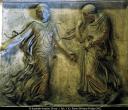
- Salome = ‘peace’ (Hebrew Shalom). Greek for peace is Eirene. Eirene is one of the second generation of Horae(=hours), goddesses who controlled orderly life. Eirene is third as Salome is third in Mark 15:40. The Horae had the task of closing and opening the gates of heaven. Such goddesses would be present at the sacrificial deaths of divine kings, as they had been at the birth of Aphrodite. Eirene had been the nurse of Demeter.
- In Robert Graves’ The White Goddess, he analyses the riddle poem Hanes Taliesin. Line 26 is, in the English translation, “I have been in the firmament with Mary Magdelene’. Graves proposed ‘Salome’ as the answer to that line.
- In his same book, p 372-3, Graves discusses the ancient goddess, Salma-ona, a name associated with easterlyness in contrast to the goddess Tar-Annis who had a name associated with westerlyness. Solomon, Salmon, Absalon and Salome are derived form the theonym Salma. Salma was the deity to whom the hill of Jerusalem was originally dedicated as Uru-Salim.
30 August 2007
The Blind and the Crucified
The final version of John’s gospel is generally taken to be later than the three synoptics. There are additions in it that can be taken as ecumenical with the European religions. The main detail that we will look at today has correspondences with Germanic and Celtic religions, although not with other Mediterranean religions.
John 19:33 But when they came to Jesus, and saw that he was dead already, they brake not his legs:
19:34 But one of the soldiers with a spear pierced his side, and forthwith came there out blood and water.
19:35 And he that saw it bare record, and his record is true: and he knoweth that he saith true, that ye might believe.
A) By adding the spear, the crucifixion of Jesus resembles those of Esus and particularly Odin. Esus had been popularized among educated Romans by Lucan’s epic poem Pharsalia in the +60s. The religion of the northern Teutons and Germans was at this time more the Vanir fertility religion rather than the Odinistic warrior religion. However the Odinists may have started on their migration from Anatolia to Russia to Scandinavia by the +first century as reported in Snorri Sturluson, popularized by Manly P. Hall and as semi-confirmed in Thor Heyerdahl’s last project before he died. Some think that the references to ‘Mercury’ in Tactitus’ Germania (circa +98) are references to Odin. However Snorri Sturluson is late (13th century), but what matters is that during the Christianization of the northern lands, the Crucifixion of Jesus and that of Odin were compared.
B) The spear itself has a fascinating afterlife appearing in the Grail legends, and being possessed by Adolf Hitler until he was defeated. However, like mos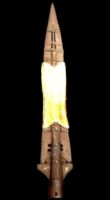 t Christian relics, there are multiple spears.
t Christian relics, there are multiple spears.
C) John does not name the soldier with the spear, but in the Acts of Pilate (4th century maybe) the soldier is said to be a centurion named Longinus. This may be based on the Greek word for spear: ‘longke’. The name of course appeals to those (see Gary Courtney and Francesco Carotta) who see the gospels as rewrites of the hagiography of Julius Caesar for Gaius Cassius Longinus was a major plotter in the Julian Passion. In Dante’s Inferno, Cassius Longinus along with Marcus Junius Brutus and Judas Iscariot are the only persons deemed sinful enough to be chewed in the three mouths of Satan.
D) Improbably, for an occupying army, the centurion Longinus was also said to be blind.
There are several parallels of blind executioners
- Baldr was the second son of Odin, the All-father. After he dreamed of his death, the gods made every object vow never to harm Baldr, but they overlooked the lowly mistletoe. Loki, the trickster, made a spear from mistletoe and took it to where the gods played their new game of throwing things at Baldr who was never harmed. He gave it to the blind god Hodr, Baldr’s brother, who threw it and inadvertently killed. This is the first event leading up to Ragnorak, and after the destruction of the old gods, a resurrected Baldr will inaugurate a new age.
- The Christian saint Alban was condemned to be beheaded, and as the deed was done his executioner became blind.
- In the Ulster tale of Fergus and Medb, they are fornicating in the lake to the chagrin of King Ailill, Medb’s husband. Ailill persuaded the blind spear-thrower Lugaid – who has never missed his aim – to throw in the direction of Fergus.
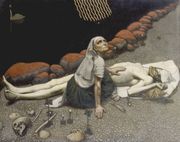
- Lemminkäinen, the hero of the Finnish epic the Kelevala, is shot by a blind herdsman, and ends up piecemeal until his mother, like Isis with Osiris, puts the body back together, and resurrects it.
- Our conceptualization of Justice sees her as blindfolded and with a sword.
- The Swiss town Sursee in canton Lucerne has an annual festival of Gansabhauet (=beheading the goose) where executioners drawn by lot are blindfolded and attack a dead goose.
As I said, John 19,34 is amazingly ecumenical.
___________________________________________________________________________________________________
Trevor Ravenscroft. The Spear of Destiny. Spearman 1972.
Manly P Hall. The Secret Teachings of All Ages: readers Edition. Tarcher/Penguin 2003 (originally 1928). p64-6.
J.C.J. Metford. Dictionary of Christian Lore and Legend. Thames and Hudson. 1983. See “Longinus, St”
John Grigsby. Warriors of the Wasteland: A Quest for the Sacrificial Cult behind the Grail Legends. Watkins Publishing. 2003 p 41.
Jaan Puhvel. Comparative Mythology. The Johns Hopkins University Press. 1987. p214.
28 August 2007
Tower Maidens
That there is some kind of relationship, perhaps a shared identity, between Paul the evangelist and Simon the magus, has been proposed by several writers. However that is a topic for another day. Correspondingly one would therefore expect some kind of relationship between Thecla and Helena, the two women who followed them.
Simon found Helena in a brothel in Tyre and purchased her freedom. He recognized her as the current hypothesis of the Holy Spirit, and she followed him on his travels.
Thecla was a young aristocrat who abandoned her family and fiancee to follow Paul. This is told in The Acts of Paul. Thecla is not mentioned at all in the Pauline epistles nor in The Acts of the Apostles. In the Eastern Churches, she was considered to be an apostle, equal to the major apostles.
The common item that we are interested in is that both women observed from towers:
Clementine Recognitions 2,12: ?Once, when this Luna of his was in a certain tower, a great multitude had assembled to see her, and were standing around the tower on all sides; but she was seen by all the people to lean forward, and to look out through all the windows of that tower. Many other wonderful things he did and does, so that men, being astonished at them, think that he himself is the great God?
Acts of Paul and Thecla, 2,1: … Thecla sat at a certain window in her house. 2:2 From whence, by the advantage of a window in the house where Paul was, she both night and day heard Paul’s sermons concerning God, concerning charity, concerning faith in Christ, and concerning prayer; 2:3 Nor would she depart from the window, till with exceeding joy she was subdued to the doctrines of faith.
There are of course other Tower Maidens. It is in fact Aarne=Thompson folktale type #310.
- Some writers try to derive Mary Magdalene from a town in Galilee, but neither archeology nor ancient texts document such a town of Magdala. More likely, magdalene is from the Aramaic, ‘migdal’ which means tower or fortress (here). Like Thecla, Mary Magdalene was an apostle, in fact she was the apostle to the apostles. It is often assumed, without any Biblical foundation, that she was a prostitute — like Helena.
- Asenath, the heroine in the +6th century Jewish romance, Joseph and Asenath , who was locked by her father the Egyptian High Priest in a tower away from men. The biblical Joseph, aware that she has converted to the Adonai cult, finally marries her.
- Valeda, a seeress of the Bructeri tribe, who prophesied victories against the Romans during the Batavian Revolt of 69-70 (whilst the Romans were a) fighting the Jews b) having a war of succession). She dwelt in a high tower and sent her prophecies by messengers. (Tacitus Histories 4, 61)
- Rapunzel is trapped in a high tower by a witch who took her at birth in exchange for vegetables taken by her parents. The tower has no entrance, and Rapunzel must let down her hair for the witch, and later the prince, to climb up. Other folktale versions tell similarly of Petrosella and Persinette.

- Barbara, a fourth century maiden from Nicomedia, Bithynia, was locked in a tower by her father to keep her from suitors. He was infuriated to find that she had converted to Christianity, but her prayers enabled her to escape. Finally he was ordered to kill his daughter, after which he was himself killed by lightening. She became a popular Christian saint who is identified with lightning and cannons, and in the Santeria religion she appears as the male god Shango.
- Ethniu. Daughter of Balor of the Fomorians, who was prophesied to be killed by his grandson. He locked her in a crystal tower, but Cian helped by the druidess Birog managed to enter and seduced her. She gave birth to triplets, but Balor threw them into the ocean. Birog saved one child and he became the god Lugh, who like Jesus was a tekton, a craftsman.
- Cleito. Plato’s Critias tells how the god Poseidon loved a mortal called Cleitas. He built a tower on an island and surrounded it by three moats. Their first son was Atlas, and the island became known as Atlantis.

- Istanbul actually has an ancient structure called the Maiden’s Tower. The major story associated with it is that of Hero and Leander. Hero was a priestess of Aphrodite who was visited by Leander who swam across the strait every night, until the night of a storm when her candles were blown out and he drowned.
- Later the story became that sultan’s daughter had been locked away so that the prophecy that she was to die of a snake bite on her 18th birthday, but the effort was in vain.
- There is also a Maiden’s Tower in Baku, seemingly of Parsee origin. The only story is that a maiden jumped to her death in the waves below (as did Hero).
- There are Magdelene Towers in Budapest, and in Rennes-le-Chateau, and at Magdelene College, Cambridge, and in Drogheda, County Louth (where the Ulster chiefs submitted to Richard II of England.
So what does this series mean?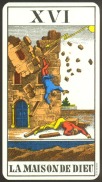
Quispel sees the maiden in the tower as a hypostatis of the cosmological potency standing on the towering house of the world.
Detering sees her as the human soul shut up in the body (the tower), who is set free by the (a) saviour.
There is also the Tower card in the Tarot. This card can symbolize ruin and catastrophe. But it can also imply illumination and epiphany, when false conceptions are left behind.
____________________________________________________________________________________________________
Edwin Johnson. Antiqua Mater: A Study of Christian Origins. London: Tr�bner & Co., Ludgate Hill 1887 p 106 (pdf). Online at http://www.radikalkritik.de/AntiquaMater1.pdf.
Gilles Quispel. Gnosis als Weltreligion. Zurich: Origo 1951 p65
Herman Detering. Der Gefälschte Paulus. Patmos 2000. Translated as “The Falsified Paul: Early Christianity in the Twilight”. The Journal of Higher Criticism, 10, 2 Fall 2003. p 169-171(pdf). Online at http://www.radikalkritik.de/FabricatedJHC.pdf.
19 August 2007
More 666 stuff
Previously I published a posting on the not usually mentioned fact that the Gospel of Mark has 666 verses as long as one deducts Mark 16:9-14 as all the better commentaries seem to tell us to do.
If you google ‘mark “verse count” 666 gospel’ my posting is the first two of the returns, and in fact is the only return to even discuss the issue. This does somewhat surprise me. I stumbled on the factoid whilst reading something or other on the Q hypothesis, where it said something like ‘of the 666 verses of Mark, X are found in Matthew and Y in Luke’, and I noted the 666. I already had the King James text in Excel, and so I added a column to count the verses. And lo and behold it checked out. How come nobody else had noted this?
Last month I added the following (with a reference to my blog posting) to the Wikipedia page, ‘Number of the Beast’:
The Gospel of Mark in the King James Bible has 678 verses, but of course the KJB has Mark as including 16:9-14, which are not in the best early Greek manuscripts, and scholarly consensus says that these twelve verses should not be included. Therefore 678 – 12 = 666.
The verse count of Mark is 666 !!!
Austin Ferrar, a theologian who did not use Gematria, describes the first six chapters of the Gospel of Mark as the ‘little gospel’ in that they foreshadow the entire Gospel. The verse count of the first six chapters is 248. Now 247 (in Gemetria one is allowed ±1) is the value of θηριον (therion=beast, as per Revelation 13:11), while 666, the full gospel, is the value of το μεγα θηριον (to mega therion = the great beast).
It survived there almost a week before some editor person removed it with the comment that ‘original research’ does not belong in Wikipedia !!!
———–
Also removed at the same time was the equally interesting fact:
666 is also the year of Islam’s founding, using the Julian calendar, which was in effect at the time Revelation was written. The Gregorian date of Islam’s founding (621 AD) is equivalent to year 666 in the Julian calendar, since we must add 45 years to a Gregorian date to convert it to the equivalent Julian date, i.e., 621 + 45 = 666.
Is this true?
- The Romans did start using the Calendar that we call ‘Julian’ in 45 BCE or 709 AUC, although they would not understand either of these counters. The calendar was actually devised by the Egyptian astronomer Sosgenes (on whom there is no Wiki page, nor any other web page), but named for the boss, as was the Napoleonic Code.
- 1 Muharram year 1 in Hijra, the Islamic Calendar, occurred on what the Christian Julian Calendar designates as 16 July 622. 622 Anno Domini (as Common Era used to be called) is 1375 AUC.
- 1375 AUC – 709 = 666
- 622 + 45 = 667. However there is no year Zero (0) in the Christian Calendar, so we deduct 1, and therefore get 666.
So the Wikipedia entry was essentially right, but needed to be better stated.
How do flukey numbers like this come to happen? We can of course say that it is one of Azathoth’s little jokes. Could the joke be Muhammad’s or that of one of his close associates’ who knew that the Julian count was around 666 and pushed for that date as the start as opposed to other candidates?
Whilst we are identifying weird coincidences, let us look at the word ‘hijra’ which means a journey in Arabic. In India the same homophone is used for the Indian transgendered tradition.
![]()
“Curiouser and curiouser!” Cried Alice (she was so much surprised, that for the moment she quite forgot how to speak good English).
13 August 2007
Passions of Cut Sleeves
There is a pioneering work on male homosexuality in China by Bert Hinsch called Passions of the Cut Sleeve. The title refers to the emperor Liu Xin (often referred to by his posthumous name Ai = lamentable) who lived 27-1 BCE and ruled from 7 BCE. His rule was incompetent and unpopular (hence his posthumous name), but has left one charming anecdote. His catamite Dong Xian ( 23 – 1 BCE) fell asleep with him on the same bed. Liu Xin cut off his sleeve rather than disturb the young man. Hence the Chinese idiom, duanxiu zhi pi (=passion of the cut sleeve).
Amazingly, almost the same story is told of Muhammad (570-632 CE), whose favourite cat, Muezza, slept on his robe, and he cut off the sleeve rather than disturb the cat.
14 July 2007
1 July 2007
The Life of Mark
For someone who is basically a postulation because a text must have an author, Mark has a remarkably detailed biography.
Walk-ons in the New Testament
In his own gospel, it has been proposed that Mark is the young man who runs off naked (14:51-2), and the servant who carried water to the house of the last supper (14:13).
In John’s gospel, it has been proposed that Mark was one of the servants at the wedding celebrations in Cana who poured out the water now turned to wine (2:1-11), and the one who hosted the disciples after the death of Jesus and to whose house the resurrected Jesus came (20:19).
In Luke’s gospel, it has been proposed that Mark was one of 70 apostles sent by Jesus (10:1); in his sequel, it is proposed that Mark is ‘John Mark’ the son a Mary(Acts 12:12,25, 15:37,39), John (13:5, 13:13), and Mark (15:39); In Luke’s epistles, Mark is mentioned at 2 Tim 4:11.
In Paul’s epistles, Mark appears at Col 4;10 as a cousin of Barnabas, and Philemon 1:24.
In Peter’s epistles he appears at 1 Peter 5:13, described as the son of the author, presumably Peter.
Outside the New Testament
Eusebius quotes Papias that Mark had been Peter’s secretary and that the gospel is based on Peter’s reminiscences.
While preaching on the shores of the Adriatic his ship took shelter from a storm in the lagoon to be later called San Francesco della Vigna, and an angel appeared and told him of the future city of Venice. Mark also founded a church at Aquileia in the lagoon.
There is a strong tradition that Mark was the first bishop of Alexandria, that he performed many miracles, including healing a cobbler with an injured hand who became his successor, Bishop Anianus. Jesus appeared to Mark in his cell before he was executed in 67 or 68 (which raises the problem of his apparent knowledge of the destruction of Jerusalem in 70 which is hinted at in his gospel). Several ancient Christian writers, Dorotheus, Eutychius and the Chronicon Paschale, state that Mark’s body was burnt. However the Acts of St Mark, 4th century, claims that a miraculous storm permitted his followers to steal away the body and bury it in a church.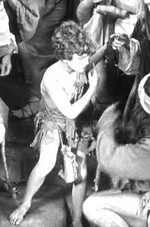

Cecil B. Demille’s King of Kings, 1927
Posthumous
Venice has a tradition that Mark came down from Heaven to rescue a slave who was devoted to his shrine, and was about to be executed. Another legend relates how during a storm, a stranger (Mark) persuades a fisherman to pick up two other saints, and then go out to sea where they encounter a ship filled with demons intending to destroy Venice. The three saints destroy the demons instead. Mark pays the fisherman with a ring from his sanctuary to be taken to the Doge.
In either 815 or 828 Venetian sailors stole most of Mark’s body and smuggled it to Venice by hiding it under pork meat which the muslim guards avoided. Venice deposed its existing patron saint, Theodore, and built the cathedral San Marco in Mark’s honour.
Copts maintain that Mark’s head is still in St. Mark Coptic Orthodox Church in Alexandria, and every year on the 30th day of the month of Babah, they commemorate its appearance.
In 1063, during the construction of a new basilica in Venice, St. Mark’s relics could not be found. However, according to tradition, in 1094 the saint himself revealed the location of his remains by extending an arm from a pillar.
In 1968 a delegation from the Coptic Pope to the Catholic Pope was given a piece of bone that had been given to the Catholic Pope by Cardinal Urbani, patriarch of Venice, and said that the rest of Mark remains in Venice.
—————————————————-
Did they get the wrong body?
The Tomb of Alexander the Great was in Alexandria, and its location was well known in Roman times. The tomb disappeared in the dark ages. Andrew Chugg argues that the Venetian sailors in 815 or 828 stole the wrong corpse. They stole that of Alexander himself, and that it is Alexander who lies in the cathedral San Marco in Venice. !!!
JCJ Metford Dictionary of Christian Lore and Legend Thames and Hudson 1983 under ‘Mark, St’
Wikipedia entry on Mark the Evangelist
Andrew Chugg Alexander’s Tomb
30 June 2007
Qlippoths and adoptions
I am going to wander around a few interesting concepts that centre on:
Mark 1:9 And it came to pass in those days, that Jesus came from Nazareth of Galilee, and was baptized of John in Jordan.
1:10 And straightway coming up out of the water, he saw the heavens opened, and the Spirit like a dove descending upon him:
1:11 And there came a voice from heaven, saying, Thou art my beloved Son, in whom I am well pleased.
1:12 And immediately the Spirit driveth him into the wilderness.
1:13 And he was there in the wilderness forty days, tempted of Satan; and was with the wild beasts; and the angels ministered unto him.
1:14 Now after that John was put in prison, Jesus came into Galilee, preaching the gospel of the kingdom of God,
Now, Qlippoth are shell entities, demons if you like, that have insinuated them selves into this universe from Yahweh’s previous attempts at universe building. Maybe the concept also applies to entities that come through from universes build by other gods, but ‘qlippoth’ is jargon from the qabala, and its authors do not admit of other gods. I am mainly interested here in the concept that Yahweh and his hypostases travel between universes or realities. Alternate realities of this sort are of course commonplace in science fiction. And the metaphor of the heavens opening is easily taken as a portal.
A phenomenon much observed of the world of Mark’s Gospel is the large number of demons that the protagonist will encounter within a short walking distance, and while the protagonist is not recognized as a messiah by the Earthlings, he is instantly recognized as Yahweh’s hypostasis by the demons or qlippoth. These two ‘facts’ would jive if the qlippoth had come through the portal with him.
————————————–
Next I am going to consider the proposal of adoptionism. As usual, the concept comes in flavours.
To the entry through the portal, contrast:
Mark 15:33 And when the sixth hour was come, there was darkness over the whole land until the ninth hour.
15:34 And at the ninth hour Jesus cried with a loud voice, saying, Eloi, Eloi, lama sabachthani? which is, being interpreted, My God, my God, why hast thou forsaken me?
The reading here is that Jesus was adopted (possessed) by the Yahweh hypostasis when it came through the portal, and later having put the Jesus body on a cross, it left it to suffer and die. This is in opposition to:
- John’s Gospel where the Christos pre-existed as the divine Logos
- Paul’s Gospel where Jesus was adopted at the Resurrection
- Matthew’s and Luke’s Gospel where Jesus is the Messiah because of Holy Blood, because of his line of descent.
The adoptionist position is one of the earliest positions in Christianity, certainly earlier than the orthodox position that grew into Catholicism. It was declared a heresy in the second century. The first prominent exponent of the position was Theodotus of Byzantium. He taught:
- Jesus was a man born of a virgin (not in Mark)
- that he lived as a man and was most pious (the second part not in Mark)
- at the Jordan the Christ came down on him in the form of a dove
- until this happened he wrought no wonders (agrees with Mark)
- the Spirit (which Theodotus calls Christus) was manifested in Jesus
There is no indication in Mark that Jesus was anybody special, pious or otherwise, before the baptism. The Spirit=Christos=the Yahweh hypostasis takes any body, and then works through it. Also, the distinction made elsewhere in Christian writings between the Holy Spirit and the Christos is not being observed here.
(The dove is/was a symbol of Aphrodite and other goddesses; Vespasian’s son who commanded the troops who destroyed Jerusalem in +70 and who succeeded him as emperor was called ‘Titus’ which means ‘wild dove’ and was also used as a slang term for ‘penis’ [cf ‘cock’ in English]; the Italian who opened up the new world for the Spanish in 1492 was also named for the dove. I will return to dove symbolism in a later post.)
Latin for adopted son is Filius adoptivus, which also of course is used to describe Octavian (later Augustus) in relation to Julius Caesar. I will return to the seepage of jargon and concepts between Christianity and Emperor Worship in another later post.
The concept of possessing another’s body has also been explored in science fiction. A popular example was the television series Quantum Leap, where the personality of a scientist jumps into the bodies (one at a time) of individuals in the past, and has to live in their life situation. An ethics of body jumping, or possession quickly comes into view. Without the consent of the possessed person, can the possession be ethical in any sense at all? Some science fiction stories have presented host who consent because they gain knowledge, health and/or longevity as part of the deal. These considerations have been considered in the Trills, humanoid host and long-lived possessing entity found in Deep Space Nine, and the Goa’uld and the Jaffa in Stargate SG-1. If we go beyond the problem of consent, the major dictate of jumping or possession would seem to be not to embarrass the body who has to go on living after the possessor retreats, and certainly not to leave the body in a dangerous or life-threatening situation. Any entity that uses a body and leaves it, for example, being crucified and about to die, is at best ethically challenged.
———————————————–
12 June 2007
Desposynoi – Part 2
I am going to bring together two quite different observations from different authors. As far as I am aware, these two have never been brought together like this.
The family of Saulus.
Robert Eisenman in his paper ‘Paul as Herodian’, which he wrote 11 years ago, and which is available in his book,The Dead Sea Scrolls and the First Christians: Essays and Translations , and also online here, proposes that Paulus aka Saulus is the same person as the Saulus found in Josephus. He supports this with a close reading of the Pauline epistles where there are a surprising number of quick references that Paul knew and was related to members of the Herodian clan, the Jewish royal family who of course were not Judeans but Edomites. Edomites had been incorporated into Judea by the expansions of the Maccabees. Therefore an Edomite clan was as legitimate a ruling dynasty in Judea as the Scottish Stuarts were as rulers of England. Were they Jews? You can argue it both ways.
Certainly Herod the so-called Great was insecure about his Jewishness, which explains his rebuilding of the Jerusalem temple, his destruction of the genealogy scrolls of the old Jerusalem families, and his marrying into the Maccabean clan which was by then a decadent dynasty and after Herod had finished marrying and executing them, there were almost none left. There have been proposals from different writers that Herodians were involved in writing the various New Testament books – I will return to these proposals in later postings. However for the purpose of this posting I am provisionally assuming that both Jesus and Paul were historical.
Of course the Herodians were client kings reigning at the will of Rome. The Jewish view of their legitimacy and the Roman view of it were quite different. In one way and another the clan managed to stay on one throne or another until the Roman-Jewish war that terminated Nero’s reign in Rome.
Robert Eisenman provides a genealogical chart of the Herodians at the end of his James the Brother of Jesus: The Key to Unlocking the Secrets of Early Christianity and the Dead Sea Scrolls. Here is the important part that shows the ancestry of Saulus. Salome was the sister of Herod called the ‘Great’. With one of her husbands, Costobarus, she had a son Antipater (there are other Antipaters in the Herodian clan so we must be careful), and the second son to this Antipator was Saulus. So Saulus is a great-nephew to Herod called the ‘Great’. The Herodians were Roman citizens, and Saulus being one of them, the mystery of his Roman citizenship as used in Acts 22:25-29 is cleared up.
The father of Jesus.
Here we turn to Robert Graves. In his King Jesus, 1946 and his Nazarene Gospel Restored, 1954, he proposes the following using the Jesus story in John’s gospel (18:29-38):
Pilate grants a private audience to Jesus, which he would have done only for a Roman citizen.
Pilate decides that Jesus is indeed king of the Jews. For a Roman like Pilate, this must mean that Jesus is king as per Roman law. Now Augustus had recognized Herod’s will nominating his son by Doris, Antipater, as his heir. If Jesus had explained that his father was Antipater secretly married to Mariam, and that his mother had remarried after Herod had changed his mind and put Antipater to death, then Pilate would indeed see Jesus as the rightful king of the Jews.
The Herod-Antipator-Jesus family was revived in Graham Phillips’ The Marian Conspiracy, 2000 (later reissued as The Virgin Mary Conspiracy, 2005). He gives no credit or even mention to Robert Graves (although Nazarene Gospel Restored is in his bibliography). Instead he gives credit for the idea of Antipater as father of Jesus to The Laws of The Jews by Joseph Schreiber, New York, 1956 (no publisher given). 1956 is later than the dates on Graves’ books and maybe Schreiber took the idea from Graves. If he came to the idea independently that is worth documenting. However there is something funny, or at least obscure, about Schreiber’s book. It is totally unknown to WorldCat, to Amazon, to the British Library and to the Library of Congress. Google finds only one reference to it: an italian site on ‘una possibile antistoria del cristianesimo‘ that as likely as not is using Phillips as a source.
Here is the genealogical chart for Herod-Antipator-Jesus.
Now let us put the two charts together:
Lo! Herod and Salome are siblings; Antipater and Antipater are cousins; Yeshua/Jesus and Saulus/Paulus are second cousins.
If we return to Luke’s Jesus Story (but not Marcion’s ), we are told that Miriamne (Mary) and Elisheba (Elizabeth) are cousins, and therefore Yohanon the Baptist and Yeshua are second cousins.
Yohanon the Baptist to Yeshua to Saulus.
John the Baptist to Jesus to Paul.
Second cousin to second cousin to second cousin.
Yohanon is not a descendant of Herod called the Great, but Yeshua and Saulus are.
Desposynoi – the family of the lord, the family of the great despot, Herod!!
These bible strands surely can be unwound in strange ways.
3 April 2007
Mary Had a Little Lamb
Its fleece was white as snow.
And everywhere that Mary went,
The Lamb was sure to go.
In Aleister Crowley’ Book 4, in the Interlude after chapter VII of part II, the author(s) present a mind-bender:
‘Every nursery rime contains profound magical secrets which are open to everyone who has made a study of the correspondences of the Holy Qabalah. To puzzle out an imaginary meaning for this “nonsense” sets one thinking of the Mysteries; one enters into deep contemplation of holy things and God Himself leads the soul to a real illumination. Hence also the necessity of Incarnation: the soul must descend into all falsity in order to attain All-Truth’.
And proceed to analyze Old Mother Hubbard; Little Bo Peep; Little Miss Muffet; Little Jack Horner; Tom, Tom the Piper’s Son; Hickery, Dickery Dock; Humpty Dumpty; Peter, Peter, pumpkin eater; Taffy was a Welshman; By, Baby Bunting!; and Pat-a-cake, pat-a-cake, baker’s man.
In a similar frame of mind let us look at Mary and her lamb.
Mary had a little Lamb:
‘Mary’ is the standard Anglicization from the Latin name ‘Maria’ which was given to all female members in the Marius clan, ‘Marius’ in turn being derived from Mars, the Roman god of war, and as such an iconic name for a major Roman family.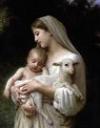
One of the major sleights of mind in Bible exegesis is the conflation of the Latin ‘Maria’ with the Hebrew ‘Miriam’ which is a completely different name. However note that ‘Miriam’ is sometimes written ‘Mariam’, and in Latin ‘Mariam’ is ‘Maria’ in the accusative (object) case. This happenstance or coincidence is a little joke of Eris or maybe of Azathoth.
There is no Maria character in the early gospels. She is unknown in Paul, in the Gospel of Thomas and in the Gospel of Peter. Nor does she appear in Q. The Gospel of John, of which the first draft may be earlier than that of Mark, has a mother of Jesus, but she is resolutely anonymous. There is no indication at all that she is called ‘Maria’, and indeed why would a Jewish woman have a Latin name? The author of Mark, be he whoever, seems to be the creator of the Maria character.
In Josephus there are several Miriams, mainly from the Maccabean family. In fact two of the Maccabean Miriams became wives of Herod, called the Great. On the other hand, there is only one Maria in Josephus (War of the Jews VI, iii), who is a woman caught in the siege of Jerusalem who is starving because the rapacious militia take all the food. She solves this by roasting and eating her own suckling son. She is described as of the House of Hyssop, and hyssop is the plant that Moses said that the Israelites should use when marking their house with the blood of the sacrificed Passover lamb. (Exodus 12:7). Roasting is also the method specified for the Passover sacrifice (Exodus 12:9). Hence War, VI, iii would seem to imply that Mary had a little lamb, whether ‘had’ means ‘was with’ or whether it means that she ate it.
Why a lamb? In addition to the Jewish tradition of the Passover lamb, there is an interesting pun: The Aramaic word ‘imera’ means ‘lamb’; the Hebrew word ‘imerah’ means ‘word’ or ‘logos’. Thus we get an equivocation that cuts directly to the heart of Christianity.
Also. A lamb was symbolic of the age of Aries which was ending in the first century CE, the time when the Jesus stories are set.
Its fleece was white as snow.
This would seem to be a reference to Mark, 9.3 where as part of the Transfiguration, Jesus’ clothes become intensely brilliantly white.
There are precedents for this in the Jewish Bible:
In Daniel 7.9 the Ancient of Days has clothing as white as snow.
Psalm 51.7 ‘wash me and I will be whiter than white’.
The practice had continued in Judeo-Islam, and white is the prescribed colour of clothing for the Hajj.
Part of the conflation of Maria with Miriam reappears here. The prototype Miriam, the sister of Moses, is sometimes referred to as ‘Snow-White Miriam’, a reference to Numbers, 12 where Miriam and Aaron speak up against Moses for his arrogance and his exogamous marriage, and Miriam is struck with ‘tzaraat’ (often mistranslated as ‘leprosy’), turning her ‘white as snow’. This story is found only in the Elohist strand of the Torah, that is the traditions of the priests of Shiloh, of Israel and Samaria, not of Judea.
And everywhere that Mary went,
Maria is a representative of the Marius clan, which in turn represents the Roman empire. Thus she stands metonymously for the Empire which stretches from Mesopotamia to Britain.
The Lamb was sure to go.Christianity would inevitably stretch all across the Empire and beyond.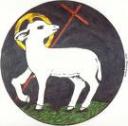
………………………
Crowley adds a warning. “If it is thought to be a joke, the reader is one useless kind of fool; if it is thought that …. The makers of the rimes had any occult intention, he is another kind of useless fool”.
It is of course claimed that the rime, Mary had a little Lamb, was composed by one John Roulstone about a Mary Sawyer who took her lamb to school in Sterling, Massachusetts in 1830. Of course it is also claimed that the first telling of a resurrected messiah, son of a virgin, was by somebody called Mark around 70 CE. But we know that there were earlier resurrected messiahs, also sons of virgins.
References:
John M. Allegro. The Dead Sea Scrolls and the Christian Myth. p174.
Joe Atwill. Caesar’s Messiah. p 45-8.
30 March 2007
The Failures of Jesus
In mediaeval style we can talk of the four failures of Jesus:
- as the prophecized messiah he was to expel the kittim, the Roman occupiers
- as Mark makes clear, he failed to explain himself to the disciples
- he failed, as he had promised, to return in the lifetime of those listening
- the church established in his name taught a doctrine contrary to his teachings
Desposynoi – Part 1
The bloodline of Jesus is referred to as “desposyni” a Latinization of the Greek “desposynoi” from “despos” (=master or lord of the household) and “-yn” (=of or belonging to). The Greeks had two major words for “lord”: “despos” and “kyrios”, the former with a more negative connotation – from which we get the English word, “despot”. When Jesus or Yahweh is called “lord” in Greek, the word used is usually “kyrios”, although there are exceptions: Luke 13:25 of Papyrus 75, 2nd Peter 2:1 (this may be a reference to Yahweh), Jude 1:4 (despos is used to describe Yahweh, and Kyrios to describe Jesus). The practice of referring to Jesus or Yahweh as “kyrios”, is a translation from the Hebrew “adonai” (=”lord”), which pious Jews are to articulate whenever they encounter YHWH as per the third of the Ten Commandments, Exodus 20:7 “Thou shalt not take the name of the Lord in vain”. The name of the Greek god, Adonis, an import from Syria, is also a Semitic word, and also means “lord”. Although to confound simple linguistic assumptions, his Etruscan counterpart was called Atunis. For those who prefer to find Roman Emperor-worship in the Jesus cult, we note that “Kyrios” was the Greek title of the emperors, equivalent to the Latin “dominus”.
If the bloodline had been named from “kyrios”, it would be known as “kyriakos”. There are two persons with “kyriakos” in their name, both with the forename of Judas. Judas Kyriakos was, according to Epiphanius, quoted by Eusebius, the last Ebionite Jewish “bishop” of Jerusalem. It was during his term that Jerusalem fell again to the Romans in the Second Jewish War (135 CE. A second “Judas Kyriakos” in the fourth century worked with Helena, mother of the emperor Constantine, to find the “True Cross”. He was a Jew, said to have taken the name Kyriakos upon his conversion, and was eventually made bishop of Jerusalem. There are also persons with “desposyni” in their name, e.g. the two Nascien I Desposyni, both aka Naasson (Nahshon); Prince of Septimania; Prefect of Narbonensis, 2nd and 5th century.
Paul ( ) and Josephus ( ) refer, somewhat enigmatically, to “James, the brother of the lord”. The gospels of Mark and Matthew (but not the others) expand the list of Jesus’ brothers to James, Simon, Jude and Joses. Paul discusses James as the leading apostle in Jerusalem, and James is also discussed in the Clementias and in Eusebius’ History of the Church. Eusebius makes Simon the successor of James, and in turn is succeeded by Judas Justus. Most writers do not equate Judas Justas with Jude, the brother of the Lord, but Robert Eisenman has made a good case that we should regard them as the same. Which leaves Joses as the only brother who does not get a term as “bishop of Jerusalem”.
Of course a similar situation pertained in Islam, where Ahl al-Bayt, the family descended from Mohammed, provided the members of the Caliphate.
Hegesippus, quoted by Eusebius, gives us the following anecdote:
There still survived of the kindred of the Lord the grandsons of Judas, who according to the flesh was called his brother. These were informed against, as belonging to the family of David, and Evocatus brought them before Domitian Caesar: for that emperor dreaded the advent of Christ, as Herod had done.
So he asked them whether they were of the family of David; and they confessed they were. Next he asked them what property they had, or how much money they possessed. They both replied that they had only 9000 denarii between them, each of them owning half that sum; but even this they said they did not possess in cash, but as the estimated value of some land, consisting of thirty-nine plethra only, out of which they had to pay the dues, and that they supported themselves by their own labour. And then they began to hold out their hands, exhibiting, as proof of their manual labour, the roughness of their skin, and the corns raised on their hands by constant work.
Being then asked concerning Christ and His kingdom, what was its nature, and when and where it was to appear, they returned answer that it was not of this world, nor of the earth, but belonging to the sphere of heaven and angels, and would make its appearance at the end of time, when He shall come in glory, and judge living and dead, and render to every one according to the course of his life.7
Thereupon Domitian passed no condemnation upon them, but treated them with contempt, as too mean for notice, and let them go free. At the same time he issued a command, and put a stop to the persecution against the Church.
When they were released they became leaders of the churches, as was natural in the case of those who were at once martyrs and of the kindred of the Lord. And, after the establishment of peace to the Church, their lives were prolonged to the reign of Trojan.
Note that they are asked if they are of “the family of David”, not of Jesus. The geneologies in Matthew and Luke perport to trace the lineage of Jesus’ legal father, Joseph, back to David.
666 the mark of Mark
There is a slight whiff of sulphur in the idea that Mark – the gospel wherein only the demons know who Jesus is, where we are told that the teachings are in parables otherwise they might be understood, where the only witnesses to the resurrection do not tell anyone, and so we cannot know, the gospel of unreliable narration – that Mark, alone in the Bible, has 666 verses.
There is an interesting structural appropriateness.The first six chapters of Mark have been described as “the little gospel”.These six chapters have 248 verses.Now 247 (apparently in Gemetria one is allowed ±1) is the value of θηριον (therion=beast, as per Revelation 13:11), while 666, the full gospel, is the value of τομεγαθηριον(to mega therion = the great beast).
Is this true?Well, like many other things biblical, it depends on which translation you are using.The classic King James Bible has 678 verses, but of course the KJB has Mark as including 16:9-20, which are not in the best early Greek manuscripts, and scholarly consensus says that these twelve verses should not be included.
678 – 12 = 666, so the answer is yes.
Except!If we look at a modern scholarly translation such as that of The Complete Gospels by Scholars Press, the end of Mark is at 16:8, but the verse-count is still not 666.By the same process of textual criticism that removed 16:9-20, some other verses have also been removed: 9:44 and 9:46 (both identical to 9:48); 11:26; 11:28 – which gives a verse-count of 662.
The 248-666 structure is tempting, and leads one to want it to be true that the original version of Mark (which of course we do not have) had 248 verses in the first six chapters, and 666 verses in total.However, this would require that we retroject the versification back into the first century, when it was certainly not in use.

